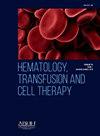PRODUCING IODINE-131 FROM TELLURIUM-130 NEUTRON ACTIVATION: STUDY OF FEASIBILITY IN THE ARGONAUTA RESEARCH REACTOR AT IEN
IF 1.8
Q3 HEMATOLOGY
引用次数: 0
Abstract
Introduction/Justification
Modern oncology faces challenges when treating elderly patients, who often have limited responses to conventional chemotherapy. To address this, theranostics combines diagnostic and therapeutic properties of radioisotopes in the same molecule, enabling personalized medicine. Iodine-131 (I-131) is a pioneering theranostic radionuclide widely used in Nuclear Medicine, for thyroid cancer due to its high affinity for thyroid tissue and beta and gamma radiation emission. In Brazil, the production and supply of I-131 are managed by the Nuclear and Energy Research Institute (IPEN) in São Paulo. However, delivering short-lived radioisotopes to remote regions presents challenges that may cause delays, affecting clinical and research applications. This highlights the need for alternative production methods to ensure timely availability of crucial radionuclides. This study explores the feasibility of producing I-131 through neutron activation of tellurium-130 at the Argonauta Research Reactor at the Nuclear Engineering Institute (IEN) in Rio de Janeiro. The Argonauta reactor, in operation since 1965, has been used for R&D in nuclear technology and the training of human resources for Brazil's Nuclear Program. Its team has optimized I-131 synthesis from tellurium-130 via neutron activation. The reactor's Nuclear Instrumentation and Radiochemistry laboratories are equipped for radiochemical processing, purification, and gamma spectrometry. Developing a validated I-131 production method at IEN would benefit local research and reduce dependence on external suppliers.
Report
In the methodology, high-purity tellurium dioxide (TeO2) was irradiated for one hour at a neutron flux of 10^9 n/cm²·s. After irradiation, I-131 was isolated using a radiochemical separation process. The irradiated oxide was dissolved in sodium hydroxide solution (4 mol/L), followed by hydrochloric acid (1 mol/L) addition to adjust the pH to 5-6. The separation method ensured I-131 retention in the aqueous phase. Gamma spectrometry confirmed radionuclide half-life, radionuclidic purity, and activity levels. The results demonstrated successful I-131 production with radionuclide purity over 95% within four hours post-irradiation. The highest activity was observed approximately 10 hours after neutron activation. Decay curve analysis confirmed the expected half-life of 8.025 days, consistent with literature values. The study also highlighted the efficiency of the radiochemical separation method in minimizing contamination from tellurium-131.
Conclusion
These findings indicate that the proposed method is a viable alternative for local I-131 production, particularly for research purposes. While the activity levels achieved are suitable for experimental applications, further optimizations, such as increasing neutron flux, extending irradiation time, or improving chemical processing efficiency, may be required to meet higher activity demands in nuclear medicine. Future work will focus on refining the process to scale up production while maintaining the stringent purity and safety standards needed for medical applications. The successful implementation of this technique could provide a reliable and accessible source of I-131 within Brazil, benefiting the scientific community.
利用碲-130 中子活化技术生产碘-131:爱因斯坦阿尔戈纳塔研究反应堆的可行性研究
现代肿瘤学在治疗老年患者时面临挑战,这些患者对传统化疗的反应通常有限。为了解决这个问题,治疗学将放射性同位素在同一分子中的诊断和治疗特性结合起来,实现个性化医疗。碘-131 (I-131)是一种开创性的治疗放射性核素,由于其对甲状腺组织和β和γ辐射的高亲和力而广泛应用于核医学,用于甲状腺癌。在巴西,I-131的生产和供应由位于圣保罗的核能研究所(IPEN)管理。然而,向偏远地区运送短寿命放射性同位素存在挑战,可能导致延误,影响临床和研究应用。这突出表明需要替代生产方法,以确保及时获得关键的放射性核素。本研究探讨了在巴西里约热内卢核工程研究所(IEN)的Argonauta研究堆通过中子活化碲-130生产I-131的可行性。Argonauta反应堆自1965年开始运行,一直用于核技术的研发和巴西核计划人力资源的培训。该团队已经优化了通过中子活化从碲-130合成I-131的方法。反应堆的核仪器和放射化学实验室配备了放射化学处理,净化和伽马能谱。在IEN开发一种有效的I-131生产方法将有利于当地的研究,并减少对外部供应商的依赖。在该方法中,以10^9 n/cm²·s的中子通量辐照高纯度二氧化碲(TeO2) 1小时。辐照后,使用放射化学分离过程将I-131分离出来。将辐照后的氧化物溶解在4 mol/L的氢氧化钠溶液中,然后加入1 mol/L的盐酸,将pH调节为5-6。该分离方法保证了I-131在水相中的保留。伽马能谱法证实了放射性核素半衰期、放射性核素纯度和活性水平。结果表明,在辐照后4小时内,成功生产了放射性核素纯度超过95%的I-131。在中子活化约10小时后观察到最高活性。衰变曲线分析证实预期半衰期为8.025天,与文献值一致。该研究还强调了放射化学分离方法在最大限度地减少碲-131污染方面的效率。这些发现表明,所提出的方法是当地生产I-131的可行替代方法,特别是用于研究目的。虽然达到的活度水平适合实验应用,但可能需要进一步优化,例如增加中子通量,延长照射时间或提高化学处理效率,以满足核医学中更高的活度要求。未来的工作将集中在改进工艺以扩大生产规模,同时保持医疗应用所需的严格纯度和安全标准。这项技术的成功实施可以在巴西境内提供可靠和可获取的I-131来源,使科学界受益。
本文章由计算机程序翻译,如有差异,请以英文原文为准。
求助全文
约1分钟内获得全文
求助全文
来源期刊

Hematology, Transfusion and Cell Therapy
Multiple-
CiteScore
2.40
自引率
4.80%
发文量
1419
审稿时长
30 weeks
 求助内容:
求助内容: 应助结果提醒方式:
应助结果提醒方式:


